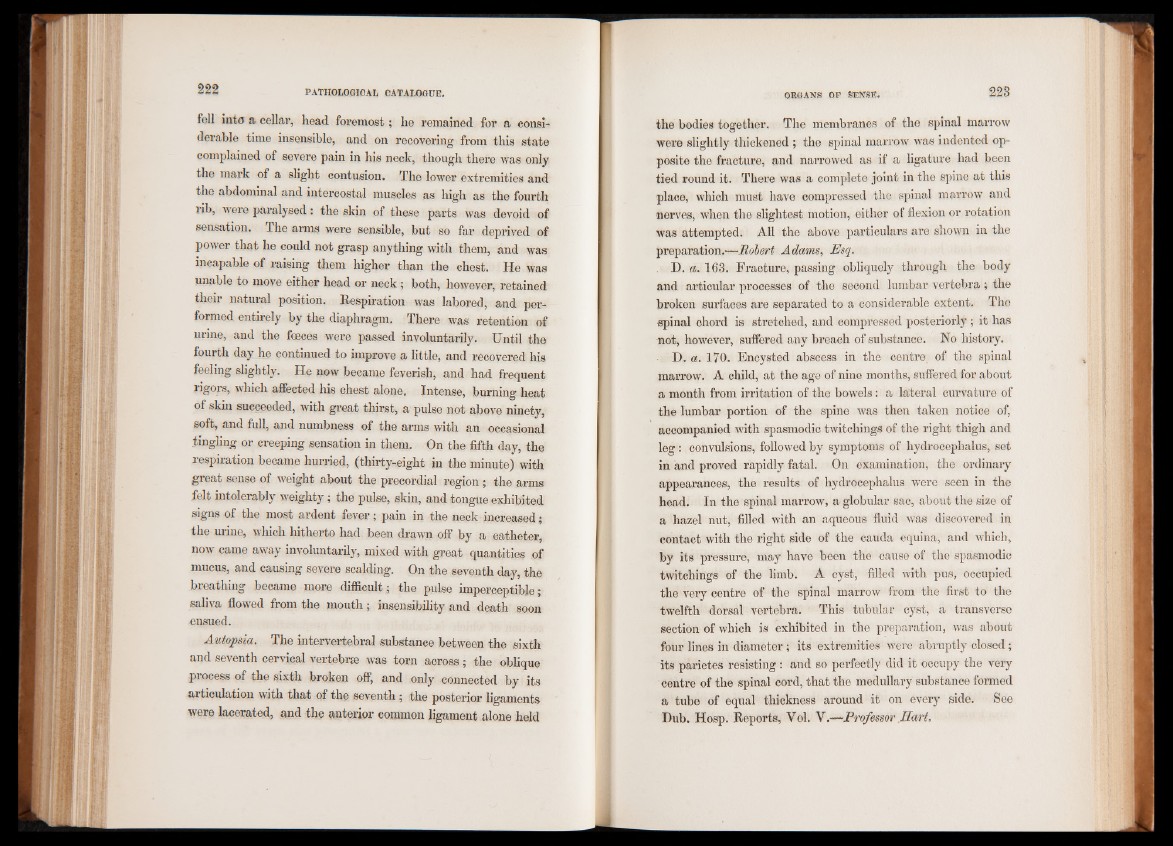
fell into a cellar, head foremost; he remained for a considerable
time insensible, and on recovering from this state
complained of severe pain in his neck, though there was only
the mark of a slight contusion. The lower extremities and
the abdominal and intercostal muscles as high as the fourth
1 ib, were paralysed: the skin of these parts was devoid of
sensation. The arms were sensible, but so far deprived of
power that he could not grasp anything with them, and was
incapable of raising them higher than the chest. He was
unable to move either head or neck; both, however, retained
their natural position. Bespiration was labored, and performed
entirely by the diaphragm. There was retention of
urine, and the foeces were passed involuntarily. Until the
fourth day he continued to improve a little, and recovered his
feeling slightly. He now became feverish, and had frequent
rigors, which affected his chest alone. Intense, burning heat
of skin succeeded, with great thirst, a pulse not above ninety,
soft, and full, and numbness of the arms with an occasional
tingling or creeping sensation in them. On the fifth day, the
respiration became hurried, (thirty-eight in the minute) with
great sense of weight about the precordial region ; the arms
felt intolerably weighty; the pulse, skin, and tongue exhibited
signs of the most ardent fever; pain in the neck increased;
the urine, which hitherto had been drawn off by a catheter,
now came away involuntarily, mixed with great quantities of
mucus, and causing severe scalding. On the seventh day, the
breathing became more difficult; the pulse imperceptible;
saliva flowed from the mouth; insensibility and death soon
ensued.
Autopsia. The intervertebral substance between the sixth
and seventh cervical vertebras was torn across; the oblique
process of the sixth broken off, and only connected by its
articulation with that of the seventh; the posterior ligaments
were lacerated, and the anterior common ligament alone held
the bodies together. The membranes of the spinal marrow
were slightly thickened ; the spinal marrow was indented opposite
the fracture, and narrowed as if a ligature had been
tied round it. There was a complete joint in the spine at this
place, which must have compressed the spinal marrow and
nerves, when the slightest motion, either of flexion or rotation
was attempted. All the above particulars are shown in the
preparation.—Robert Adams, Esq.
D. a. 163. Fracture, passing obliquely through the body
and articular processes of the second lumbar vertebra; the
broken surfaces are separated to a considerable extent. The
spinal chord is stretched, and compressed posteriorly ; it has
not, however, suffered any breach of substance. No history.
D. a. 170. Encysted abscess in the centre of the spinal
marrow. A child, at the age of nine months, suffered for about
a month from irritation of the bowels: a lateral curvature of
the lumbar portion of the spine was then taken notice of,
accompanied with spasmodic twitchings of the right thigh and
leg: convulsions, followed by symptoms of hydrocephalus, set
in and proved rapidly fatal. On examination, the ordinary
appearances, the results of hydrocephalus were seen in the
head. In the spinal marrow, a globular sac, about the size of
a hazel nut, filled with an aqueous fluid was discovered in
contact with the right side of the cauda equina, and which,
by its pressure, may have been the cause of the spasmodic
twitchings of the limb. A cyst, filled with pus, occupied
the very centre of the spinal marrow from the first to the
twelfth dorsal vertebra. This tubular cyst, a transverse
section of which is exhibited in the preparation, was about
four lines in diameter; its extremities were abruptly closed;
its parietes resisting: and so perfectly did it occupy the very
centre of the spinal cord, that the medullary substance formed
a tube of equal thickness around it on every side. See
Hub. Hosp. Beports, Vol. V.—Professor Ilart,